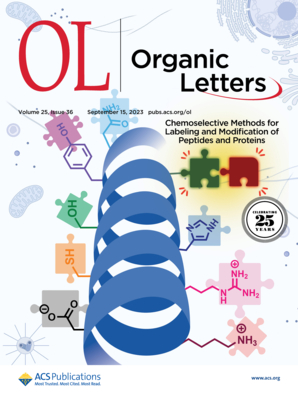Self-Assembled Cationic Cages for Anion Recognition in Aqueous Solution
IF 5
1区 化学
Q1 CHEMISTRY, ORGANIC
引用次数: 0
Abstract
Two types of supramolecular cages were synthesized in high yields via a self-assembled dynamic organic reaction: tricationic cages, PT3+/MT3+, and hexacationic cages, PH6+/MH6+. The formar imine cages are only stable in their in situ self-assembly solutions and showed limited anion recognition. In contrast, the latter hydrazone cages are kinetically inert and isolable as solid-state compounds via counterion exchange. The hexacationic cages exhibited significantly enhanced anion binding properties. For example, both PH6+ and MH6+ with chloride counterions can recognize Br–, NO3– and SO42– in aqueous media, where these anions are considered highly hydrated.

水溶液中用于阴离子识别的自组装阳离子笼。
通过自组装的动态有机反应,高产量合成了两种超分子笼:三价笼PT3+/MT3+和六价笼PH6+/MH6+。甲醛亚胺笼只在原位自组装溶液中稳定,阴离子识别有限。相比之下,后一种腙笼具有动力学惰性,可通过反离子交换作为固态化合物分离。六价笼的阴离子结合性能显著增强。例如,带氯离子的PH6+和MH6+都能识别水介质中的Br-、NO3-和SO42-,这些阴离子被认为是高度水合的。
本文章由计算机程序翻译,如有差异,请以英文原文为准。
求助全文
约1分钟内获得全文
求助全文
来源期刊

Organic Letters
化学-有机化学
CiteScore
9.30
自引率
11.50%
发文量
1607
审稿时长
1.5 months
期刊介绍:
Organic Letters invites original reports of fundamental research in all branches of the theory and practice of organic, physical organic, organometallic,medicinal, and bioorganic chemistry. Organic Letters provides rapid disclosure of the key elements of significant studies that are of interest to a large portion of the organic community. In selecting manuscripts for publication, the Editors place emphasis on the originality, quality and wide interest of the work. Authors should provide enough background information to place the new disclosure in context and to justify the rapid publication format. Back-to-back Letters will be considered. Full details should be reserved for an Article, which should appear in due course.
 求助内容:
求助内容: 应助结果提醒方式:
应助结果提醒方式:


